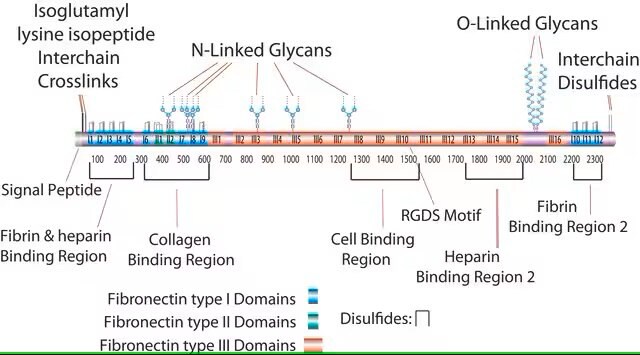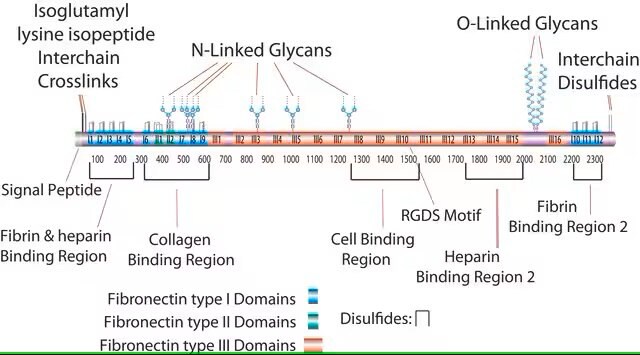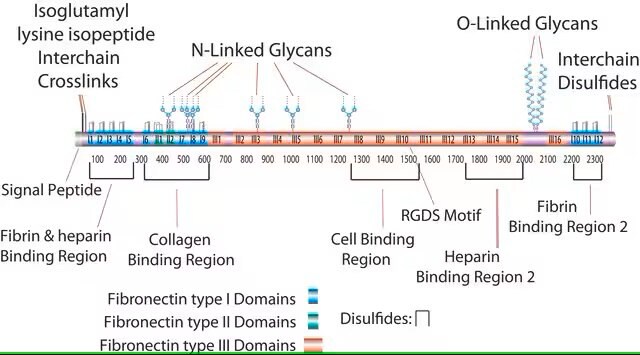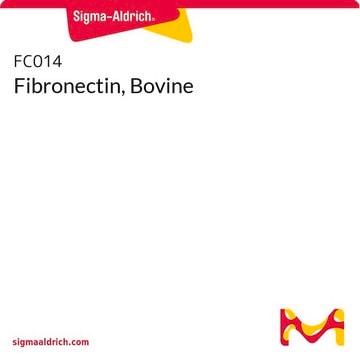The recommended storage duration for Fibronectin (F0895) is up to 1 year at 4°C. There has been no testing done on its stability after storage at -80°C or -20°C. A diluted solution of 10ug/mL in PBS can be stored at 4°C for 2-4 weeks. However, the solution cannot be reused to coat culture ware surfaces multiple times; the recommended process involves coating surfaces with a minimal volume, allowing them to air dry for 45 minutes at room temperature, and then storing the cultureware at 4°C for 2-4 weeks.
F0895
Human Fibronectin
from human plasma, liquid, 1 mg/mL, suitable for cell culture
Synonym(e):
Fibronectin
About This Item
Empfohlene Produkte
Produktbezeichnung
FIBRONEKTIN AUS HUMANPLASMA, liquid, 0.1% (Solution), BioReagent, suitable for cell culture
Biologische Quelle
human plasma
Qualitätsniveau
Sterilität
sterile
Produktlinie
BioReagent
Form
liquid
Verpackung
pkg of 1 mg
pkg of 2 mg
pkg of 5 mg
Konzentration
0.1% (Solution)
Methode(n)
cell culture | mammalian: suitable
Oberflächendeckung
1‑5 μg/cm2
Löslichkeit
saline: 0.05 M (Tris-buffered)
UniProt-Hinterlegungsnummer
Bindungsspezifität
Peptide Source: Collagen
Versandbedingung
wet ice
Lagertemp.
2-8°C
Angaben zum Gen
human ... FN1(2335)
Suchen Sie nach ähnlichen Produkten? Aufrufen Leitfaden zum Produktvergleich
Allgemeine Beschreibung
FN tritt als Dimerprotein auf, das durch zwei Disulfidbindungen am Ende der C-terminalen Region verbunden ist.[2] Innerhalb der Fibronektin-Struktur sind die Domänen nahe der Amino- und Carboxy-terminalen Regionen der Peptidketten angeordnet.[3] Darüber hinaus wurde beobachtet, dass trotz der Entstehung aus einem einzelnen Gen bis zu 20 verschiedene Varianten dieses Gens beim Menschen identifiziert wurden.[2]
Anwendung
Biochem./physiol. Wirkung
Leistungsmerkmale und Vorteile
- Adhäsives Glykoprotein
- Aus Humanplasma gewonnen
- Empfohlene Oberflächenabdeckung von 1–5 μg/cm2
Angaben zur Herstellung
Bei der Beschichtung von Kulturoberflächen sollte Fibronectin in ausgeglichener steriler Kochsalzlösung verdünnt und möglichst dünn aufgetragen werden. Die behandelte Oberfläche sollte dann 45 Minuten bei Raumtemperatur luftgetrocknet werden und ist 2-4 Wochen bei 2-8 °C haltbar.
Hinweis zur Analyse
Rechtliche Hinweise
Haftungsausschluss
Ähnliches Produkt
Lagerklassenschlüssel
12 - Non Combustible Liquids
WGK
WGK 1
Flammpunkt (°F)
Not applicable
Flammpunkt (°C)
Not applicable
Hier finden Sie alle aktuellen Versionen:
Analysenzertifikate (COA)
Die passende Version wird nicht angezeigt?
Wenn Sie eine bestimmte Version benötigen, können Sie anhand der Lot- oder Chargennummer nach einem spezifischen Zertifikat suchen.
Besitzen Sie dieses Produkt bereits?
In der Dokumentenbibliothek finden Sie die Dokumentation zu den Produkten, die Sie kürzlich erworben haben.
Kunden haben sich ebenfalls angesehen
Artikel
Fibronectin (FN) plays crucial roles in extracellular matrix fibril assembly and cellular interactions.
Lung organoids are valuable 3D models for human lung development and respiratory diseases. The 3dGRO™ differentiation protocol generates organoids from human iPSCs in 4 steps.
The extracellular matrix (ECM) and its attachment factor components are discussed in this article in relation to their function in structural biology and their availability for in vitro applications.
The extracellular matrix (ECM) is secreted by cells and surrounds them in tissues.
Protokolle
Fibronectin auf die gewünschte Konzentration verdünnen. Die optimalen Anhaftungsbedingungen sind vom Zelltyp und der Anwendung abhängig. Die typische Beschichtungskonzentration beträgt 1–5 ug/cm2. Protokoll, Produkte und häufig gestellte Fragen zur Fibronectin-Beschichtung.
Dilute fibronectin for cell attachment, varying per cell type. Coating protocol, products, and FAQs provided.
-
What is the recommended storage duration for Fibronectin (F0895) at 4°C, -20°C, and -80°C? How long can a diluted solution of 10ug/mL in PBS be stored at 4°C? Is it possible to reuse the Fibronectin solution to coat culture ware surfaces multiple times?
1 answer-
Helpful?
-
-
What is the recommended dilution rate for coating the culture surface with F0895-1MG Fibronectin as per the preparation instructions?
1 answer-
The recommended dilution rate for coating the culture surface with F0895-1MG Fibronectin, as per the preparation instructions, is to start with a concentration in the range of 1 - 5 ug/cm^2. For a 96-well plate well with a surface area of about 0.34 cm^2, approximately 2 ul of F0895 further diluted in saline with a total volume of around 50 ul would be sufficient to cover the bottom of the well.
Helpful?
-
-
Is Product F0895, Fibronectin from human plasma, sterile?
1 answer-
Fibronectin 0.1% solution is a sterile product. It is tested for sterility. The sterility test results can be found on the lot-specific certificate of analysis.
Helpful?
-
-
How much Product F0895, Fibronectin from human plasma, do I use for my application?
1 answer-
Recommended for use as a cell culture substratum at 1-5 μg/cm2 or 0.5-50 μg/mL. Optimal concentration depends on cell type as well as the application or research objectives.
Helpful?
-
-
How should I store and handle Product F0895, Fibronectin from human plasma?
1 answer-
Recommended storage of this material is 2-8 °C. Vortexing, excessive agitation, repeated freezing and thawing of reconstituted fibronectin are not recommended.
Helpful?
-
-
What is the Department of Transportation shipping information for this product?
1 answer-
Transportation information can be found in Section 14 of the product's (M)SDS.To access the shipping information for this material, use the link on the product detail page for the product.
Helpful?
-
-
What is the solvent for Product F0895, Fibronectin from human plasma?
1 answer-
This material is solubilized in a 0.05 M Tris-buffered saline, pH 7.5.
Helpful?
-
Active Filters
Unser Team von Wissenschaftlern verfügt über Erfahrung in allen Forschungsbereichen einschließlich Life Science, Materialwissenschaften, chemischer Synthese, Chromatographie, Analytik und vielen mehr..
Setzen Sie sich mit dem technischen Dienst in Verbindung.










